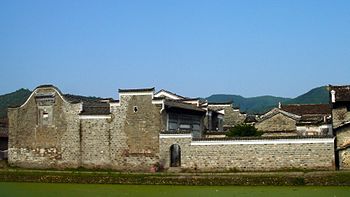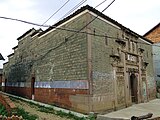Architecture of Jiangxi

Architecture of Jiangxi refers to the traditional masonry houses, residential compounds, monuments, and academies built in Jiangxi Province of East China.
Overview
Architectural features
Materials
Natural materials are highly preferred. Raw materials, such as stone, wood, and brick, are abundantly used for the respect for nature. Stone, as the fundamental part in the construction, is variable across different regions; sandstone, limestone, granite are the most frequent choices. Wood is generally used for the framework of buidings, because of its warmth and workability. Compared to the style in surrouding regions like Zhejiang or Anhui where outer walls are painted white with quicklime, bricks are explicitly viewed in Jiangxi architecture, which therefore demands well-developed techniques to produce fine bricks.
Fengshui design
Fengshui theories have been playing an important role in the entire course of construction, for instance, choosing the site, house direction, etc..
Jiangxi school
Jiangxi school (Chinese: 江西派), also called Xingshi school (Chinese: 形势派, literally "school of location") is a prominent school in Chinese Fengshui, which emphasizes the harmony between nature and human, namely between environment and residents. Yang Junsong (Chinese:杨筠松) is the founder of this school.
Building types
Jiangxi residential architecture is renowned for its exterior and interior design, relating to the surrounding context and settings by using Fengshui principles.
The traditional houses still preserved in Jiangxi were mostly built during the Ming dynasty and Qing dynasty. These buildings are characterized by gables of dark bricks, with white lines under eaves, covered by black tiles. They are often elaborately decorated by wood, stone and brick carvings, ink painting, clay sculpture, and sometimes Nuoxi elements.
Important historical monuments built in Jiangxi in the traditional styles include ancestral shrines, Shuyuan (Confucian) academies, and paifang (memorial arches).
Residential architecture
Memorial architecture
Educational architecture
Religious architecture
Decorative structures
Stone carving
Stone carving in Jiangxi architecture is very much outstanding as Jiangxi has abundant resources of many kinds of stones. Roughly speaking, sandstone is preferred in western Jiangxi and limestone is usually seen in the east, while granite is typically used in northwestern region. However, the combination of different stones can also be viewed for seeking aesthetics. Stone is elaborately carved, especially at entrance door, column bases and other visible parts inside the building.
Brick carving
Wood carving
Ink painting
Infrastructure
Defensive wall
Pavement
Bridge
Water well
Significant buildings and areas
Major National Historical and Cultural Sites
Influence on neighbourhood
Regional difference
Gallery
Ancestral halls and shrines
-
Ancestral shrine in Ji'an
-
Huangcun Jingyitang, Wuyuan County, Jiangxi.
-
Door of Huangcun Jingyitang.
-
Bed chamber of Huangcun Jingyitang.
-
Yu Family Ancestral Hall, Wangkou Village.
-
More Yu Family Ancestral Hall.
Pavilion
-
Pavilion of Prince Teng at Nanchang, Front view.
-
Pagoda of Prince Teng.
-
A picture of Pavilion of Prince Teng.
City Wall
-
Ganzhou's City Wall.
Others
-
Imperial Kiln in Jingdezhen.














